South Creake Lent Array
During Lent in many parts of northern and western Europe, it was the custom for churches to be adorned with what has come to be known in modern liturgical parlance as 'Lent or Lenten array' and I have written extensively on the subject in a number of other articles on this blog. From the beginning of Lent, the practice was that altars, reredoses and images in church, were covered completely in hangings and veils of off-white material, which deprived the worshipper of the usual colour and ornament of the church building. For want of a better phrase, these veils and hangings forced upon the people a visual fast - they were forced to do without the familiar symbolism of the church for the duration of Lent. Quite often the veils, frontals and dossals were stencilled with imagery, that referred to the image that was beneath, or the dedication of the altar - a tantalising hint of what was temporarily lost from view. The tradition of Lent array was well known to nineteenth century ecclesiologists, but it was only in the late ninteenth and early years of the twentieth century, that it came to be revived within the Anglican church, ostensibly under the influence of the Alcuin Club. Sadly very little Lenten array now survives, it has been more or less systematically replaced year by year by the ubiquitous Purple, which is a shame, as it is a tradition that has a useful symbolic purpose. Today I would like to share with you one striking example of the Use of Lenten Array from those that survive in use.
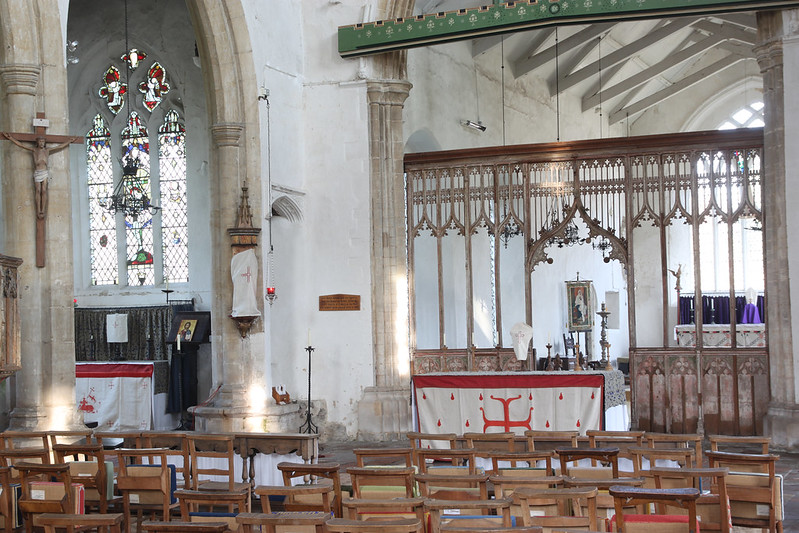
The parish church of Our Lady St Mary at South Creake is in north Norfolk, close to the shrine of Our Lady of Walsingham. Mostly fourteenth and fifteenth century, it is a handsome and noble structure that was built when this part of Norfolk was prosperous. A succession of rectors in the twentieth century, adorned the church with an eclectic set of furnishings, and modern images of the saints sit amid the old stone and woodwork. The aisles, empty since the Reformation, have been topped with altars to form beautiful chapels and the whole place has an air of continuity, as though the despoliation of the sixteenth century never happened. The church has a full set of Lent Array and from the beginning of Lent each altar and all the images are covered in veils and hangings of stout linen. Some of them have been made for South Creake some have been brought in from elsewhere.
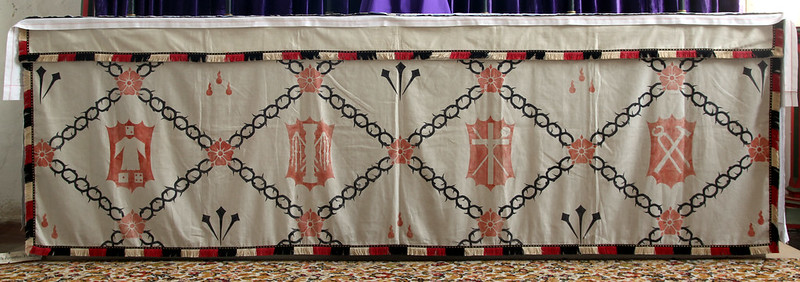
Let's begin at the east end in the chancel, where the high altar has a Lent frontal made (probably in the 1920s or 30s) by the Warham Guild, the business Percy Dearmer established to make this sort of thing. The frontal is unbleached linen with a fringe of black and red and the motifs on it are stencilled. The stencilling is a striking design - a black lattice is formed from thorn, in allusion to the Lord's crown; this lattice encloses a series of motifs. Shields charged with Instruments of the Passion in a band, with above and below, alternating stencils of triple nails and triple drops of blood.
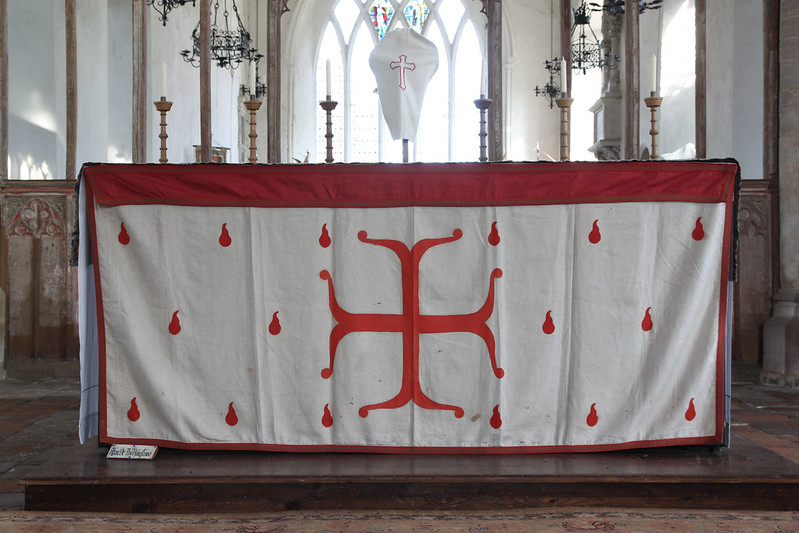

The parish church of Our Lady St Mary at South Creake is in north Norfolk, close to the shrine of Our Lady of Walsingham. Mostly fourteenth and fifteenth century, it is a handsome and noble structure that was built when this part of Norfolk was prosperous. A succession of rectors in the twentieth century, adorned the church with an eclectic set of furnishings, and modern images of the saints sit amid the old stone and woodwork. The aisles, empty since the Reformation, have been topped with altars to form beautiful chapels and the whole place has an air of continuity, as though the despoliation of the sixteenth century never happened. The church has a full set of Lent Array and from the beginning of Lent each altar and all the images are covered in veils and hangings of stout linen. Some of them have been made for South Creake some have been brought in from elsewhere.

Let's begin at the east end in the chancel, where the high altar has a Lent frontal made (probably in the 1920s or 30s) by the Warham Guild, the business Percy Dearmer established to make this sort of thing. The frontal is unbleached linen with a fringe of black and red and the motifs on it are stencilled. The stencilling is a striking design - a black lattice is formed from thorn, in allusion to the Lord's crown; this lattice encloses a series of motifs. Shields charged with Instruments of the Passion in a band, with above and below, alternating stencils of triple nails and triple drops of blood.

Moving west into the nave, we come to the eastern nave altar, which is dedicated to the precious blood. Here we have a Lenten frontal that was clearly made for South Creake and more recently too. It's a bolder composition, but it takes as it's cue from some of the visual language of the high altar frontal. A blood red cross fleury is set against a ground of droplets of blood.
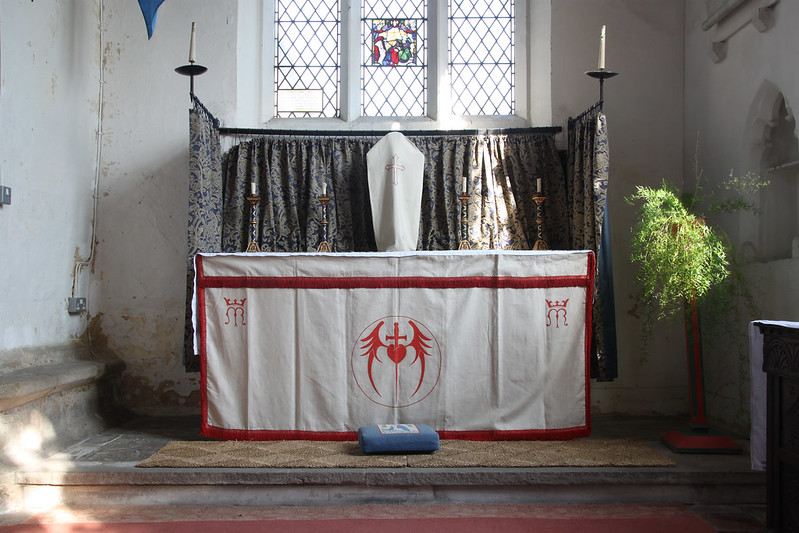
Into the south aisle and to the altar of the Blessed Virgin Mary. Again the Lenten frontal appears to have been locally made and is not quite so successful a composition I feel. A central roundel is charged with a winged hear, pierced by a sword - a reference to the Immaculate Heart of Mary, a very post-medieval devotion. In the extreme corners of the frontal are crowned MR monograms, which one cannot help feeling should be slightly larger and more centrally placed.
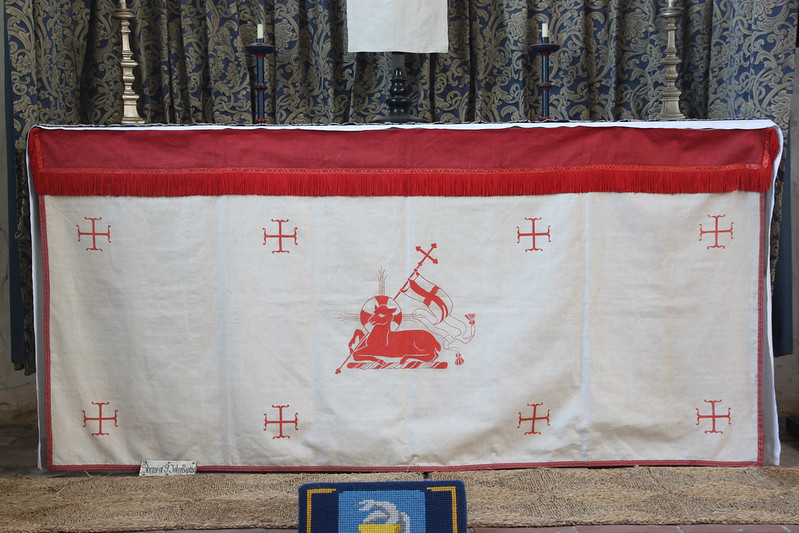
Crossing over to the north nave aisle and to the altar of St John the Baptist. Again a local product I think, perhaps 1930s or 40s and quite charming.
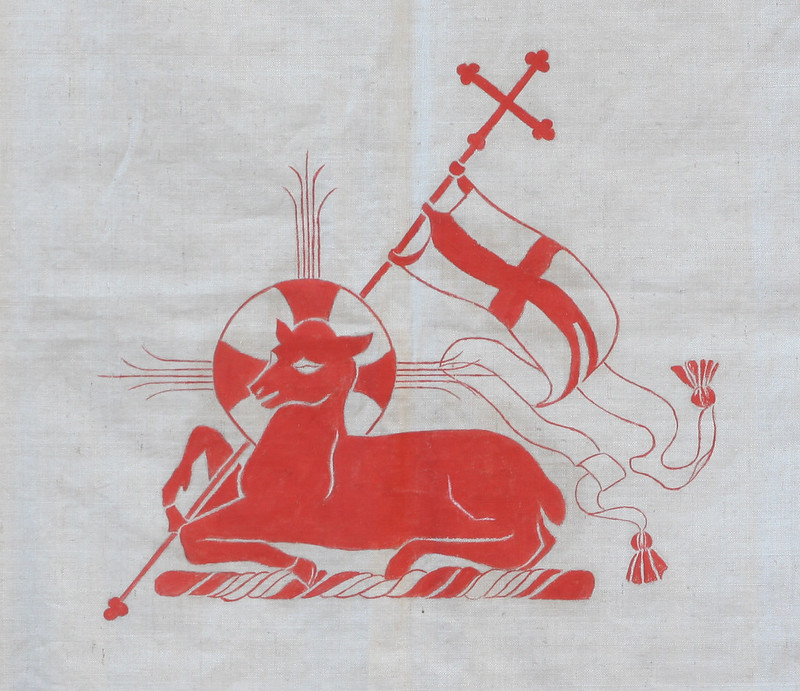
A detailed composition, the Agnus Dei symbol or St John is in the centre, surrounded by eight crosses fleury. The Agnus Dei is a lovely piece of work, in this case painted on to the cloth, rather than stencilled. The work reminds me of the work of Enid Chadwick, the artist and illustrator, who did so much work at nearby Walsingham.
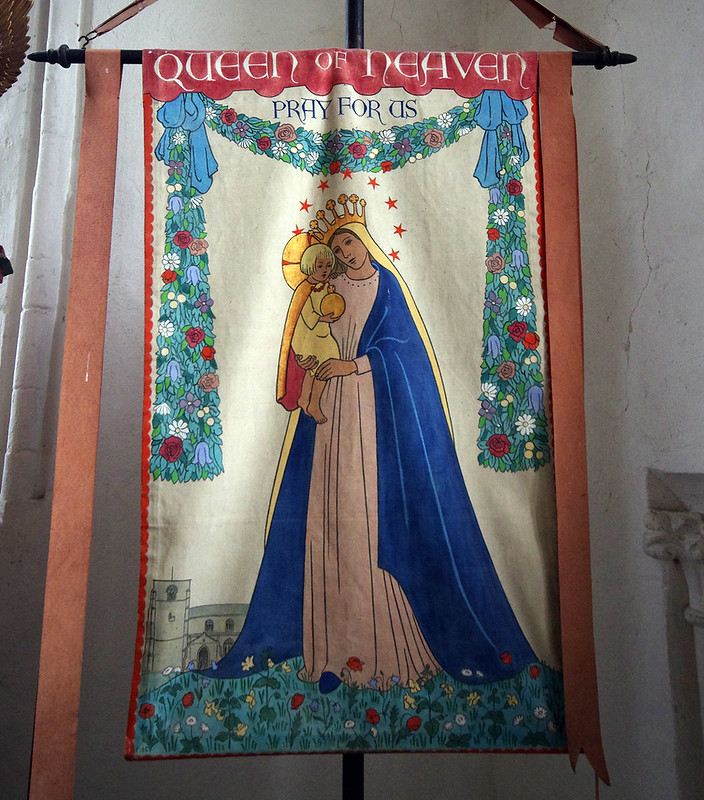
South Creake does have a banner by Chadwick and though a hunch, I do wonder if this and the frontal in the Lady Chapel are by her.
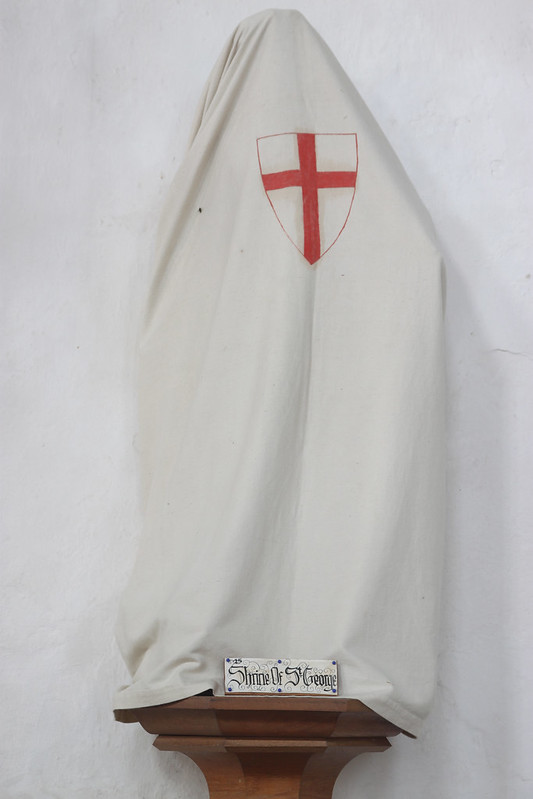
All the images in the church and there are many, are also veiled, each with an individual linen bag to cover it. On to these is either painted directly or applied to little panels of linen, the attributes associated with each saint. These blood red emblems allow the enshrouded figures to be identified.
St George has a handy cross of St George on a shield.
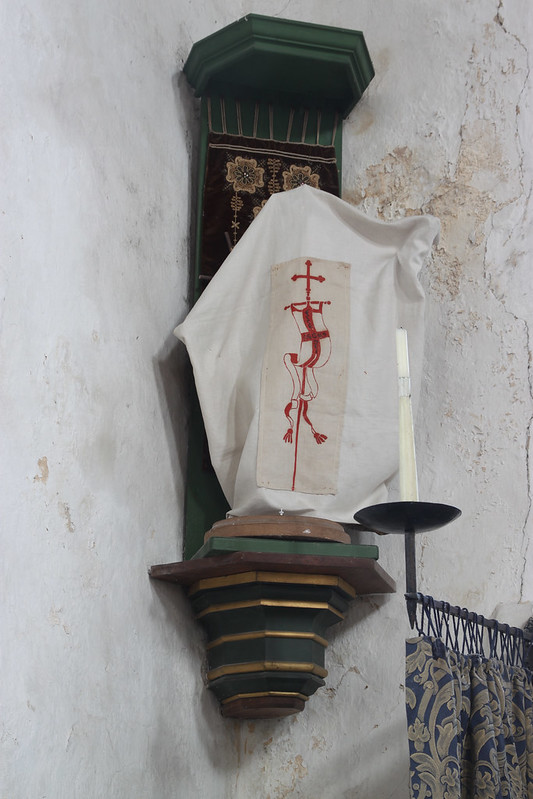
St John the Baptist has the flag of the resurrection, that matches the one held by the lamb of God on the frontal of his altar.
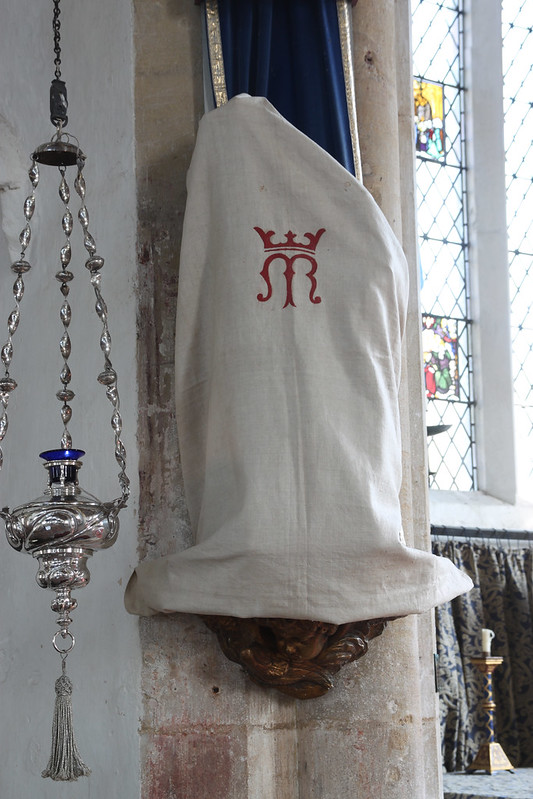
Our Lady has a crowned MR monogram on her veil.
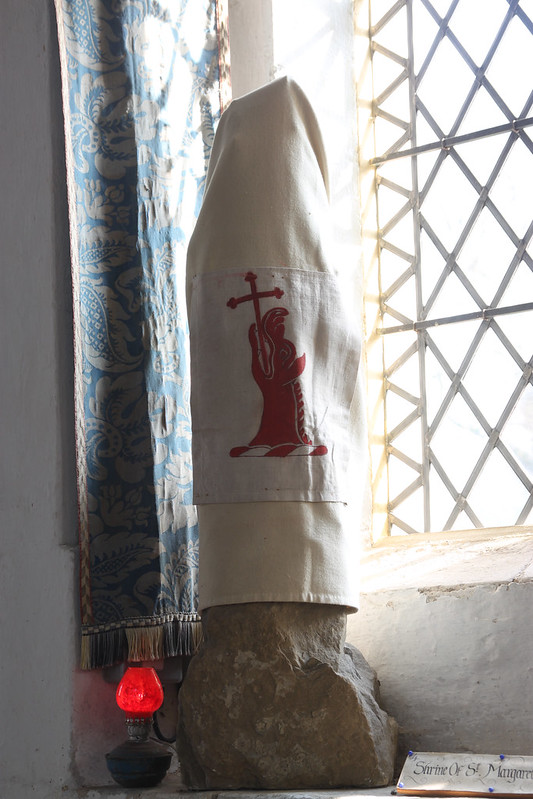
St Margaret has her own image on hers.
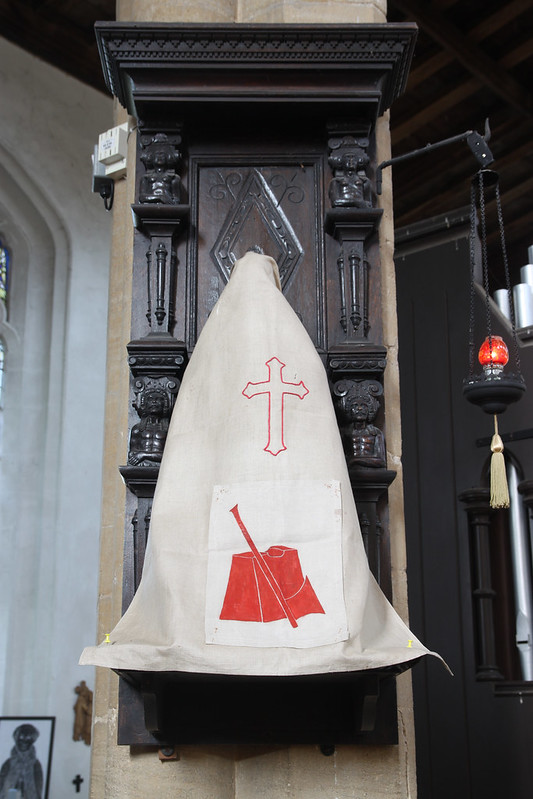
My favourite of all has to be the shrine of King Charles I, blessed Charles the Martyr. His veil has a little block and axe, the instruments of his 'martyrdom'.
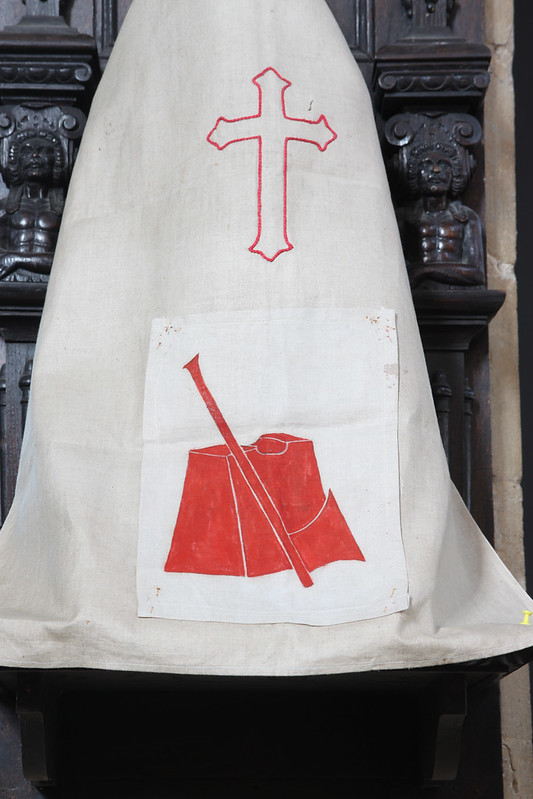

Into the south aisle and to the altar of the Blessed Virgin Mary. Again the Lenten frontal appears to have been locally made and is not quite so successful a composition I feel. A central roundel is charged with a winged hear, pierced by a sword - a reference to the Immaculate Heart of Mary, a very post-medieval devotion. In the extreme corners of the frontal are crowned MR monograms, which one cannot help feeling should be slightly larger and more centrally placed.

Crossing over to the north nave aisle and to the altar of St John the Baptist. Again a local product I think, perhaps 1930s or 40s and quite charming.

A detailed composition, the Agnus Dei symbol or St John is in the centre, surrounded by eight crosses fleury. The Agnus Dei is a lovely piece of work, in this case painted on to the cloth, rather than stencilled. The work reminds me of the work of Enid Chadwick, the artist and illustrator, who did so much work at nearby Walsingham.

South Creake does have a banner by Chadwick and though a hunch, I do wonder if this and the frontal in the Lady Chapel are by her.

All the images in the church and there are many, are also veiled, each with an individual linen bag to cover it. On to these is either painted directly or applied to little panels of linen, the attributes associated with each saint. These blood red emblems allow the enshrouded figures to be identified.
St George has a handy cross of St George on a shield.

St John the Baptist has the flag of the resurrection, that matches the one held by the lamb of God on the frontal of his altar.

Our Lady has a crowned MR monogram on her veil.

St Margaret has her own image on hers.

My favourite of all has to be the shrine of King Charles I, blessed Charles the Martyr. His veil has a little block and axe, the instruments of his 'martyrdom'.


Comments
I grew up to purple hangings (RC), and looked forward to the haunting tone of 'Lumen Christi,'
and rthe responce 'Deo gratias'
Long Live Lenten Array !!!
Long Live Lenten Array !!!
Simon
Thank you for your writing.